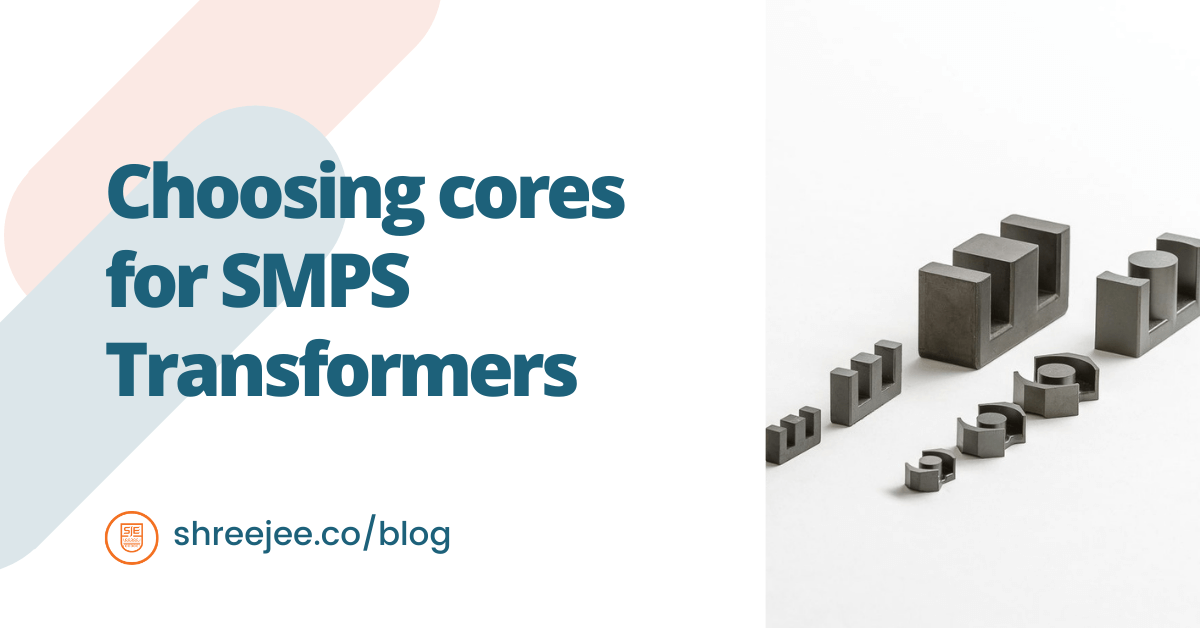The selection of the magnetic components, especially transformer cores, to be used in a Switch Mode Power Supply (SMPS) design is the most crucial element.
Core choice is generally based upon the application’s power requirements, the switching topology, and the frequency required.
The power requirement and choosing the suitable topology of SMPS’ is the first and foremost step as the designer must consider the trade-offs between them. This article will discuss considerations for choosing the core shape core size.
Core Shape or Core Geometry
To minimize losses, selecting the correct core shape, also called core geometry, and the window configuration is critical for high-frequency transformer design. Here’s a summary of some of the most important considerations for core size selections:
- Generally, ferrite cores are an excellent choice for high-frequency applications. For operation below 500 kHz, a core material with a permeability of 2000 to 2500 is preferred.
- Preferences for EFD and EPC cores are given for low-profile applications.
- To minimize AC winding resistance, the window area of the windings should be as broad as possible. This wide winding window maximizes the winding breadth, thereby reducing the number of winding layers.
- The availability of broad winding areas in ETD and EER cores makes them particularly good for higher power designs and multiple output designs.
- PQ cores require fewer turns than E cores and take up slightly less PC board space; however, they are expensive.
- EE and EF cores are good choices and are generally used with either vertical or horizontal bobbins (vertical bobbins are suitable to achieve minimal footprint).
- A large core size will be needed for a margin-wound type transformer than for a triple insulated (Litz wire) type transformer. Large core sizes to allow room for margins between windings.
Core Size
Here are some variables involved in estimating the appropriate core size needed for a transformer:
- One of the best and easy ways to select the proper core for a transformer is to refer to the manufacture’s core selection guide.
- The core area product is obtained mathematically by multiplying the core cross-section area by the window area available for winding. This formula is widely used for an initial estimate of core size for a given application.
- Core power handling capability does not scale linearly with neither core volume nor area of the product. Since the surface area dissipating heat does not increase in proportion to the volume producing the heat, a large transformer must operate at a lower power density.
The following table gives a glimpse of core types as the function of power throughput:
| Output power level (W) | Recommended core size and shape |
| 0–10 | EFD15, EF16, EE19, EFD20, EFD25 |
| 10–20 | EE19, EFD20, EF20, EI22, EFD25 |
| 20–30 | EI25, EFD25, EFD30, ETD29, EER28(L) |
| 30–50 | EI28, EER28(L), ETD29, EFD30, EER35 |
| 50–70 | EER28L, ETD34, EER35, ETD39 |
| 70–100 | ETD34, EER35, ETD39, EER40 |
| 100–150 | EI50, EE40, EER42 |
| 150–200 | EI60, EE50, EE60, EER49 |
| 200–500 | ETD44, ETD49, E55 |
| > 500 | ETD59, E65, E70, E80 |
Despite the enormous importance of the core selection process, not all companies are as thorough as Shreejee Electronics. Our engineers can help you choose the suitable material for your projects. Send us an RFQ mentioning your application details. As the most reliable transformer manufacturer in India, we are more than happy to help you choose the right product solution.
